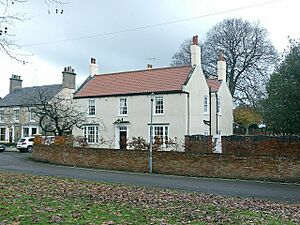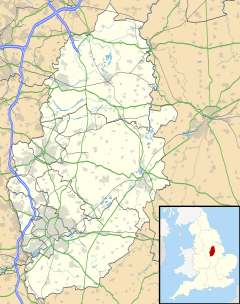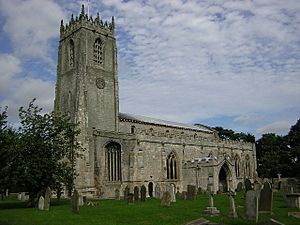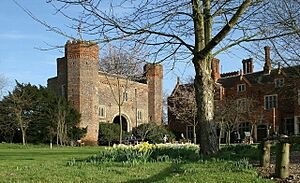Blyth, Nottinghamshire facts for kids
Quick facts for kids Blyth |
|
|---|---|
| Village and civil parish | |
 The Old Vicarage, Blyth. |
|
Parish map |
|
| Area | 3.18 sq mi (8.2 km2) |
| Population | 1,265 (2021) |
| • Density | 398/sq mi (154/km2) |
| OS grid reference | SK 625869 |
| • London | 135 mi (217 km) SE |
| District |
|
| Shire county | |
| Region | |
| Country | England |
| Sovereign state | United Kingdom |
| Post town | WORKSOP |
| Postcode district | S81 |
| Dialling code | 01909 |
| Police | Nottinghamshire |
| Fire | Nottinghamshire |
| Ambulance | East Midlands |
| EU Parliament | East Midlands |
| UK Parliament |
|
Blyth is a village and civil parish in Nottinghamshire, England. It is located in the East Midlands, north west of East Retford, near the River Ryton. In 2021, about 1,265 people lived in Blyth. The village is important because it sits right next to the A1, a major highway in the UK.
Contents
Exploring Blyth's Location
Blyth is situated right next to the A1, a very important highway in England. It is at the southern end of a long motorway section that comes from Doncaster. In 2008, the old roundabout was replaced with a 'grade separated junction'. This means that roads cross over or under each other, so cars do not have to stop at traffic lights. You can also find the Moto Blyth Services here, which is a place for drivers to rest and refuel. Other roads like the A634 also pass through the village.
A Look Back at Blyth's History
Blyth Priory: An Ancient Church
The priory church of St. Mary and St. Martin is one of the oldest examples of Norman architecture in the country. It was part of a Benedictine monastery founded in 1088. A monastery is a place where monks live and worship. This priory was started by Roger de Builli, who was one of William the Conqueror's followers.
The founder and other people who supported the priory gave it land, money, and churches. At first, monks from a main monastery in Rouen, France, came to live here. Sometimes, French monks had to be sent back because of their behaviour or because they did not like the climate.
In 1536, during a visit to the priory, it was said that five of the monks had done serious wrong things. Because of this, the priory was closed down. The head monk, George Dalton, received some money to live on. After the priory was closed, the eastern part of the church was pulled down. A new tower was built at the western end of the church. You can find more information at St Mary and St Martin's Church, Blyth.
Blyth Hall: A Grand Estate
In 1603, a man named Sir Edward Stanhope sold the Blyth estate to Robert Saunderson. Later, in 1635, the Saunderson family sold the large 490-acre estate to John Mellish, a merchant from London.
His son, Edward Mellish, came back to England in 1671. In 1684, he decided to pull down the old priory buildings and build Blyth Hall. This grand house was built just north of the church. Edward Mellish was the High Sheriff of Nottinghamshire in 1692–93. A High Sheriff is a very old and important official in a county. When Edward died, he left the property to his cousin's son, Joseph Mellish.
The Mellish family owned Blyth Hall until 1806. Then, it was sold to Joshua Walker, whose family made iron in Rotherham. Joshua's son, Henry Frederick Walker, also became the High Sheriff of Nottinghamshire in 1852–53. Towards the end of the 1800s, Francis Willey, 1st Baron Barnby, a wool merchant, bought the hall. His son, Vernon Willey, 2nd Baron Barnby, who was a Member of Parliament, later owned it.
Sadly, Blyth Hall was pulled down in 1972. Today, a housing estate stands where the hall used to be.
On the village green, you can still see the old Leper Hospital of St John the Evangelist. It is believed to have been built by the Knights Hospitaller, a famous group of knights. It was re-established in 1226 and was even used as a school in 1695. Blyth is also close to Hodsock Priory.




